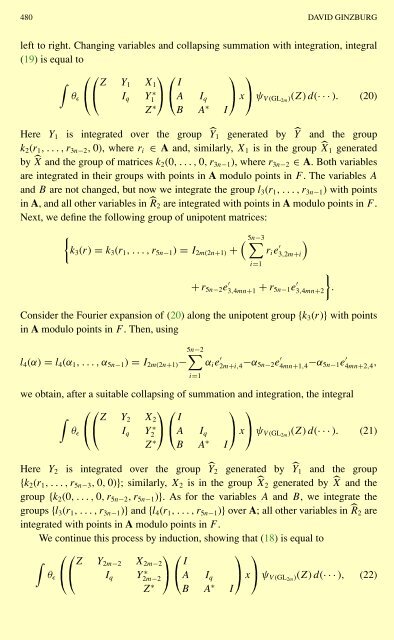A NULLSTELLENSATZ FOR AMOEBAS
A NULLSTELLENSATZ FOR AMOEBAS
A NULLSTELLENSATZ FOR AMOEBAS
You also want an ePaper? Increase the reach of your titles
YUMPU automatically turns print PDFs into web optimized ePapers that Google loves.
480 DAVID GINZBURG<br />
left to right. Changing variables and collapsing summation with integration, integral<br />
(19) is equal to<br />
⎛⎛<br />
⎞ ⎛ ⎞ ⎞<br />
∫ Z Y 1 X 1 I<br />
θ ɛ<br />
⎝⎝<br />
I q Y1<br />
∗ ⎠ ⎝A<br />
I q<br />
⎠ x⎠ ψ V (GL2m )(Z) d(···). (20)<br />
Z ∗ B A ∗ I<br />
Here Y 1 is integrated over the group Ŷ 1 generated by Ŷ and the group<br />
k 2 (r 1 ,...,r 3n−2 , 0), where r i ∈ A and, similarly, X 1 is in the group ̂X 1 generated<br />
by ̂X and the group of matrices k 2 (0,...,0,r 3n−1 ), where r 3n−2 ∈ A. Both variables<br />
are integrated in their groups with points in A modulo points in F . The variables A<br />
and B are not changed, but now we integrate the group l 3 (r 1 ,...,r 3n−1 ) with points<br />
in A, and all other variables in ̂R 2 are integrated with points in A modulo points in F .<br />
Next, we define the following group of unipotent matrices:<br />
{<br />
( 5n−3<br />
∑ )<br />
k 3 (r) = k 3 (r 1 ,...,r 5n−1 ) = I 2m(2n+1) + r i e ′ 3,2m+i<br />
i=1<br />
+ r 5n−2 e ′ 3,4mn+1 + r 5n−1e ′ 3,4mn+2<br />
Consider the Fourier expansion of (20) along the unipotent group {k 3 (r)} with points<br />
in A modulo points in F . Then, using<br />
5n−2<br />
∑<br />
l 4 (α) = l 4 (α 1 ,...,α 5n−1 ) = I 2m(2n+1) − α i e ′ 2m+i,4 −α 5n−2e ′ 4mn+1,4 −α 5n−1e ′ 4mn+2,4 ,<br />
i=1<br />
we obtain, after a suitable collapsing of summation and integration, the integral<br />
⎛⎛<br />
⎞ ⎛ ⎞ ⎞<br />
∫ Z Y 2 X 2 I<br />
θ ɛ<br />
⎝⎝<br />
I q Y2<br />
∗ ⎠ ⎝A<br />
I q<br />
⎠ x⎠ ψ V (GL2m )(Z) d(···). (21)<br />
Z ∗ B A ∗ I<br />
Here Y 2 is integrated over the group Ŷ 2 generated by Ŷ 1 and the group<br />
{k 2 (r 1 ,...,r 5n−3 , 0, 0)}; similarly, X 2 is in the group ̂X 2 generated by ̂X and the<br />
group {k 2 (0,...,0,r 5n−2 ,r 5n−1 )}. As for the variables A and B, we integrate the<br />
groups {l 3 (r 1 ,...,r 3n−1 )} and {l 4 (r 1 ,...,r 5n−1 )} over A; all other variables in ̂R 2 are<br />
integrated with points in A modulo points in F .<br />
We continue this process by induction, showing that (18) is equal to<br />
⎛⎛<br />
⎞ ⎛ ⎞ ⎞<br />
∫ Z Y 2m−2 X 2m−2 I<br />
θ ɛ<br />
⎝⎝<br />
I q Y2m−2<br />
∗ ⎠ ⎝A<br />
I q<br />
⎠ x⎠ ψ V (GL2m )(Z) d(···), (22)<br />
Z ∗ B A ∗ I<br />
}<br />
.
















